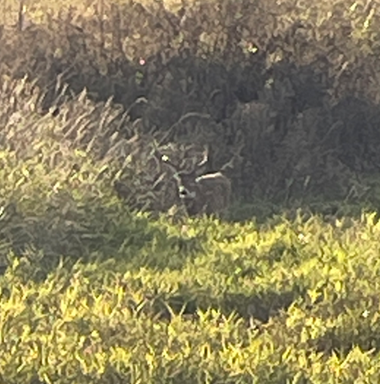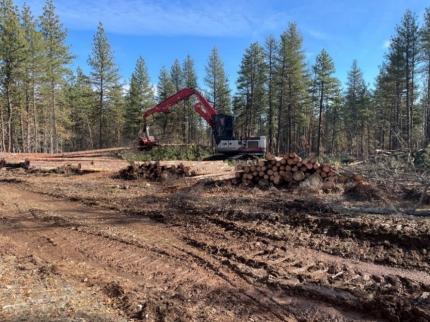Managing Wildlife Populations
Columbian White-tailed Deer Surveys: Biologists Holman and Stephens have conducted two surveys for Columbian white-tailed deer on Puget Island. Surveys consist of driving designated routes and counting all deer and classifying them as doe, fawn, or buck. The primary purpose of the survey is to generate a doe to fawn ratio. This survey is done in partnership with the U.S. Fish and Wildlife Service, the Cowlitz Tribe, Oregon Department of Fish and Wildlife, and with support from volunteers. Survey results will be summarized in future reports. Thanks to Customer Service Specialist Kean and Regional Operations Manager Varley for participating in the surveys.


Providing Recreation Opportunities
Access Areas: Access area staff members and a Department of Corrections crew have been working together at many access areas removing debris, leaves, and fallen trees. This time of year is very busy with this type of maintenance, especially after wind and rain storms. Throughout the week, multiple areas were cleaned including Kress Lake. The Department of Corrections crew was a huge help to Washington Department of Fish and Wildlife access staff members enabling them to service multiple sites a week.


Providing Conflict Prevention and Education
District 9 Urban Coyote: Maintenance staff members from a Clark County school contacted Washington Department of Fish and Wildlife regarding a coyote with mange that had become habituated to human presence and was interacting with people and lunchboxes at the school. Wildlife Conflict Specialist Jacobsen helped the school staff members coordinate with U.S. Department of Agriculture Wildlife Services on next steps to address the issue.
Injured Deer: Wildlife Conflict Specialist Jacobsen made another attempt to capture a deer in Skamania County that has a piece of hard plastic stuck on its hoof, making the limb unusable. The deer has had this issue since mid-summer and shows up regularly at a particular residence. It changes its activity patterns every time Jacobsen tries to catch it. This time was no different.
Jacobsen did observe a beautiful black-tailed deer female with a “double throat patch” while waiting for the injured deer to show up. Jacobsen discouraged the landowner from placing out feed for the deer in the neighborhood. This issue is addressed at length in the Washington Department of Fish and Wildlife brochure “Feeding Deer in Urban and Suburban Areas…Is it Harmful?” (PDF)

Orphaned Cougar Kittens: Wildlife Conflict Specialist Jacobsen received a call from a homeowner in Klickitat County regarding three cougar kittens that were after her chickens the previous night. Despite the fact that the homeowner had secured her three chickens in a chain-link enclosure, the kittens somehow managed to grab one of the chickens through the fence and kill it.

Jacobsen arrived later that morning to assess the situation and while he was knocking on the homeowner’s door to speak with them, he looked over and saw the three cougar kittens trying to get the chickens again. Based on the behavior of the kittens and the frequency with which they were visiting the residence without an adult present (verified by trail camera footage), Jacobsen determined the kittens were orphaned and would continue to cause trouble until they eventually starved to death.
Jacobsen consulted with Cougar Specialists Beausoleil and Welfelt and agreed that capturing them was the best option for the kittens. Jacobsen baited three live traps and caught two of the kittens the first night. The third kitten was captured the following night. Biologists Bergh and Wickhem and Volunteer Downing assisted in transferring the three very feisty kittens from the traps into crates for transport.


In setting the traps in the brush, Jacobsen was extensively exposed to several defoliated poison oak branches and suffered extreme itching for the next two weeks – the price of helping to rescue orphans. All three kittens were placed in Cougar Specialist Beausoleil’s care until their permanent homes in captive facilities could be determined. The kittens were approximately 17 weeks old and between 21 and 23 pounds. Orphaned cougar kittens less than one year old cannot survive in the wild without their mother and cannot be rehabilitated and taught to catch natural prey by humans. Therefore, the only alternative to starvation in the wild is placement in an accredited facility (usually a zoo) capable of caring for cougars. All three kittens will soon be headed to the east coast for final placement in the coming week.


Damage Prevention Cooperative Agreements: Wildlife Conflict Specialist Jacobsen met with several crop producers in Klickitat County to renew their annual Damage Prevention Cooperative Agreements.
Livestock Carcass Sanitation: Wildlife Conflict Specialist Jacobsen collected and hauled deceased livestock carcasses away from a livestock operation in Klickitat County to help prevent the Big Muddy wolf pack from scavenging on carcasses in the area.
Conserving Natural Landscapes
Klickitat Wildlife Area Forest Health Enhancement Project Phase II: Operations on the Forest Health Enhancement Project began this month. This project involves thinning timber on the Soda Springs Unit. The objective is to improve forest health by thinning the stand, thereby reducing competition among trees for scarce water resources, improve forest resistance to wildfire by removing some of the fuel, and leave a more open understory that is less conducive to fire spread, and do this while maintaining quality habitat for the western gray squirrel.
The western gray squirrel was recently uplisted to endangered status in Washington State. They depend on a forested environment. By promoting forest health and resistance to wildfire, we will help western gray squirrels persist on the wildlife area. The current project is to thin between 247 and 270 acres of western gray squirrel occupied forest. As of 2021, there were 797 western gray squirrel nests within the project area. The whole area was resurveyed for nest trees in 2023 prior to the implementation of the project. At that time, adjustments were made to protect the nest trees.
Washington Department of Fish and Wildlife completed a similar project in 2018 (Phase I) on the Klickitat Wildlife Area. They found that two years after the forest thinning was done there was no significant change in the number of western gray squirrel nests within the project area compared to the number of nests prior to harvest. This project demonstrates that a carefully planned and implemented forest management project can be undertaken within a western gray squirrel occupied forest while conserving the important habitat features that the squirrels require.



Simcoe Unit Fence Inspection: Wildlife Area Manager Van Leuven was aware of unauthorized fence construction on the Simcoe Mountains Unit as well as damage to newly constructed property boundary fences. VanLeuven visited the property to investigate the extent of the damage. Unfortunately, the fence was cut in seven places. VanLeuven recorded the coordinates and mapped all of the damage. The photo below shows an example of the condition of the fence. Manager VanLeuven spoke with a neighbor of the Simcoe Unit, who explained that he had cut the fences and why. A meeting has been scheduled to resolve the issue.

Another incident occurred during the inspection of the fence, where VanLeuven discovered two men cutting firewood without a permit on the Washington Department of Fish and Wildlife (WDFW) property along a road beyond a sign informing visitors, “No Unauthorized Vehicles Beyond This Point”. VanLeuven contacted them and later forwarded information to WDFW officers for possible follow-up. While on the Simcoe Unit, VanLeuven added reflective tape to the three new panel gates to make them visible at night, to avert damage from vehicle collisions.
Providing Education and Outreach
Bat Outreach Presentation: Biologist Stephens gave a presentation about bats to a group of Lewis County residents. The presentation was organized by the Lewis County Stream Team and the focus was bat biology, white-nosed syndrome, Washington Department of Fish and Wildlife bat research, and creating backyard bat habitat. The presentation was well-attended, the group was very interested in bats, and they asked many great questions.
Vancouver Wildlife League Presentation: Biologist Holman presented on southwest Washington black-tailed deer research and management to a group of approximately 25 members of the Vancouver Wildlife League. The presentation featured summaries of WDFW research on doe/fawn ecology related to forest management, buck survival, current methods for monitoring black-tails, and future strategies for black-tail monitoring. Thanks to Ungulate Specialist Oates for providing much of the presentation material. Thanks to the Vancouver Wildlife League for their involvement in hunting and fishing related activities and advocacy spanning nearly 100 years in southwest Washington.